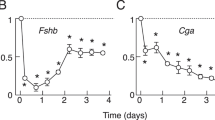Abstract
Changes in LH and FSH levels were evaluated before and after metformin administration. In all 25 patients, plasma LH levels were significantly reduced after 3 months of metformin administration (500–1,500 mg/day). When patients were classified into a PCOS group (n = 12) or a non-PCOS group (n = 13), the reduction in LH levels only remained significant in the PCOS group. Plasma FSH levels were unchanged following metformin treatment when all patients were considered collectively and when patients were classified based on PCOS. LH/FSH ratio was significantly reduced only in the PCOS group. To examine the direct effect of metformin on gonadotropin-secreting cells, gonadotroph cell line, LβT2 was used for in vitro studies. Treatment of LβT2 cells with metformin modified neither the LHβ nor the FSHβ subunit promoter activity. The GnRH-induced LHβ promoter activity was not modulated in the presence of metformin. In contrast, GnRH-induced FSHβ promoter activity was significantly potentiated in the presence of metformin. Our results suggest that metformin does indeed modulate the basal level of LH and the LH/FSH ratio, albeit indirectly, particularly in the patients with PCOS. Additionally our results suggest that metformin does directly regulate FSH gene expression.


Similar content being viewed by others
References
Goodarzi MO, Azziz R (2006) Diagnosis, epidemiology, and genetics of the polycystic ovary syndrome. Best Pract Res Clin Endocrinol Metab 20:193–205
Hughes E, Collins J, Vandekerckhove P (2000) Clomiphene citrate for ovulation induction in women with oligo-amenorrhoea. Cochrane Database Syst Rev 3:CD000056
Burghen GA, Givens JR, Kitabchi AE (1980) Correlation of hyperandrogenism with hyperinsulinism in polycystic ovarian disease. J Clin Endocrinol Metab 50:113–116
Santana LF, de Sa MF, Ferriani RA et al (2004) Effect of metformin on the clinical and metabolic assessment of women with polycystic ovary syndrome. Gynecol Endocrinol 19:88–96
Thierry van Dessel HJ, Lee PD, Faessen G, Fauser BC, Giudice LC (1999) Elevated serum levels of free insulin-like growth factor I in polycystic ovary syndrome. J Clin Endocrinol Metab 84:3030–3035
Creanga AA, Bradley HM, McCormick C, Witkop CT (2008) Use of metformin in polycystic ovary syndrome: a meta-analysis. Obstet Gynecol 111:959–968
Nardo LG, Rai R (2001) Metformin therapy in the management of polycystic ovary syndrome: endocrine, metabolic and reproductive effects. Gynecol Endocrinol 15:373–380
Barbieri RL, Makris A, Randall RW et al (1986) Insulin stimulates androgen accumulation in incubations of ovarian stroma obtained from women with hyperandrogenism. J Clin Endocrinol Metab 62:904–910
DeFronzo RA, Goodman AM (1995) Efficacy of metformin in patients with non-insulin-dependent diabetes mellitus. The multicenter metformin study group. N Engl J Med 333:541–549
Mansfield R, Galea R, Brincat M, Hole D, Mason H (2003) Metformin has direct effects on human ovarian steroidogenesis. Fertil Steril 79:956–962
Genazzani AD, Battaglia C, Malavasi B et al (2004) Metformin administration modulates and restores luteinizing hormone spontaneous episodic secretion and ovarian function in nonobese patients with polycystic ovary syndrome. Fertil Steril 81:114–119
Kaiser UB, Sabbagh E, Katzenellenbogen RA, Conn PM, Chin WW (1995) A mechanism for the differential regulation of gonadotropin subunit gene expression by gonadotropin-releasing hormone. Proc Natl Acad Sci USA 92:12280–12284
Bedecarrats GY, Kaiser UB (2003) Differential regulation of gonadotropin subunit gene promoter activity by pulsatile gonadotropin-releasing hormone (GnRH) in perifused L beta T2 cells: role of GnRH receptor concentration. Endocrinology 144:1802–1811
Adashi EY, Resnick CE, D’Ercole AJ, Svoboda ME, Van Wyk JJ (1985) Insulin-like growth factors as intraovarian regulators of granulosa cell growth and function. Endocr Rev 6:400–420
Nestler JE, Powers LP, Matt DW et al (1991) A direct effect of hyperinsulinemia on serum sex hormone-binding globulin levels in obese women with the polycystic ovary syndrome. J Clin Endocrinol Metab 72:83–89
Dunn CJ, Peters DH (1995) Metformin. A review of its pharmacological properties and therapeutic use in non-insulin-dependent diabetes mellitus. Drugs 49:721–749
Velazquez EM, Mendoza S, Hamer T, Sosa F, Glueck CJ (1994) Metformin therapy in polycystic ovary syndrome reduces hyperinsulinemia, insulin resistance, hyperandrogenemia, and systolic blood pressure, while facilitating normal menses and pregnancy. Metabolism 43:647–654
Moghetti P, Castello R, Negri C et al (2000) Metformin effects on clinical features, endocrine and metabolic profiles, and insulin sensitivity in polycystic ovary syndrome: a randomized, double-blind, placebo-controlled 6-month trial, followed by open, long-term clinical evaluation. J Clin Endocrinol Metab 85:139–146
Alarid ET, Windle JJ, Whyte DB, Mellon PL (1996) Immortalization of pituitary cells at discrete stages of development by directed oncogenesis in transgenic mice. Development 122:3319–3329
Harada T, Kanasaki H, Mutiara S, Oride A, Miyazaki K (2007) Cyclic adenosine 3′, 5′monophosphate/protein kinase A and mitogen-activated protein kinase 3/1 pathways are involved in adenylate cyclase-activating polypeptide 1-induced common alpha-glycoprotein subunit gene (Cga) expression in mouse pituitary gonadotroph LbetaT2 cells. Biol Reprod 77:707–716
Winters SJ, Moore JP (2007) Paracrine control of gonadotrophs. Semin Reprod Med 25:379–387
Rice S, Pellatt L, Ramanathan K, Whitehead SA, Mason HD (2009) Metformin inhibits aromatase via an ERK (extracellular signal-regulated kinase)—mediated pathway. Endocrinology 150:4794–4801
Author information
Authors and Affiliations
Corresponding author
Rights and permissions
About this article
Cite this article
Oride, A., Kanasaki, H., Purwana, I.N. et al. Effects of metformin administration on plasma gonadotropin levels in women with infertility, with an in vitro study of the direct effects on the pituitary gonadotrophs. Pituitary 13, 236–241 (2010). https://doi.org/10.1007/s11102-010-0223-x
Published:
Issue Date:
DOI: https://doi.org/10.1007/s11102-010-0223-x




